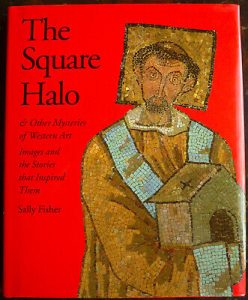The Square Halo
Women’s History Month is barreling toward us and I am happily working on bringing you another March full of mini-interviews with people who are doing interesting work in women’s history. In the meantime, I’m sharing some of the books that I’ve rediscovered in the process of finding room on my office shelves for the books I used in writing The Dragon From Chicago.
I must admit, I’m enjoying looking at books that I haven’t touched or thought about for years—in some cases decades—and sharing them with you, even though it is definitely slowing down progress on reclaiming my project bookshelf.* (Not to mention the related process of filing stuff in my project boxes.) At least some of you seem to be enjoying it as well—or at least I am causing you to add books to your own TBR lists. (As far as I’m concerned, this is a WIN.) Don’t be surprised if you see more posts like this once Women’s History Month is over.**
In the meantime, let’s take a look at The Square Halo and Other Mysteries of Western Art by Sally Fisher.
The subtitle of The Square Halo sums up what the book is about: Images and the Stories That Inspired Them. It is a crisply written, beautifully illustrated introduction to the stories behind works of Western art that were created in periods before art for arts sake was a thing, specifically the Middle Ages through the Renaissance.*** Fisher, who worked for many years at the Metropolitan Museum of Art, looks at paintings that were shaped by meaning as well as aesthetics—paintings that we often hurry past in museums on our way to art works that seem more accessible—and untangles the symbols, ideas and attitudes that are impenetrable to the modern viewer. Her goal is to not only answer the question “what’s going on?” in these paintings, but to help a modern reader understand the ideas behind what’s happening on the canvas.
The book is organized according to themes rather than chronology. Most of the themes are Biblical or drawn from the stories of Christian saints, though Fisher includes a chapter on stories from classical Greece and Rome. (It seems perfunctory to my eye, though I doubt if it did when I bought the book soon after its publication in 1995.)
Testing to see how the book holds up, these many years later, I turned to the story of Judith and Holofernes, which I am familiar with as a subject in Romantic painting and which Bridget Quinn discussed in Broad Strokes in her chapter on Baroque artist Artemisia Gentileschi (1593-1653). Fisher’s account of the story is clear and complete. Her description of the painting she uses to illustrate it directed my eye to elements I might have missed on my own. (I’m used to more dramatic paintings of the subject.) She places it in the broader context of medieval and Renaissance paintings on the subject. But I must admit, it didn’t grab me.
I then turned to her discussion of halo shapes, which was absolutely fascinating. Perhaps because I didn’t remember any of it from reading it the first time.
The Square Halo will keep its place on my shelves as a useful reference work to use alongside other books about art, but I am not tempted to read it again from start to finish.
*This would only matter if I had another project in the wings waiting to fill that shelf, but I don’t. Or rather, I have a growing list of possible projects waiting for me to have enough time and clarity of thought to explore them.
**Though you also have a horde of women journalists coming your way.
***I would argue that “art for arts sake” did not become an important idea until the nineteenth century. But paintings created between the Renaissance and the Romantic movement often build on very different stories than the Christian-centric art of earlier periods. Classical mythology and history, for instance, played an important role in the history painting of the seventeenth and eighteenth centuries. But I digress.






Pamela,
Thank you for reminding me of Sally Fisher’s wonderful book. I bought it back in 1996 when I was teaching a high school humanities course–really I was writing the syllabus–and then used parts of it in teaching. I searched my shelves in fear that I had given the book away. The teacher in me must share books willy-nilly and then buy them again. The red spine was there, and after I thumbed through and reread the section on the halo in art, I decided that I would reread it, a page or two at a time before I go to bed, as I often do with art books.
Your energies are mostly focused on preserving little known stories from history and you are a brilliant and disciplined researcher. I am a dilettante dipping into history and art and poetry and religion as I am led. I do try to concentrate on preserving some stories from my area by writing them down to share. But I love learning the things you share.
Thank you for what you do and how you share your work and ideas.
Cheryl Hilderbrand
Thank you for the kind words. I don’t think our styles are that different: I, too, follow my curiosity where it leads me.